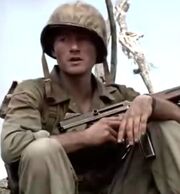
Robert Leckie with a Thompson
Overview[]
In 1938, the Thompson submachine gun was adopted by the U.S. military, serving during World War II and beyond.
There were two military types of Thompson SMG.
- The M1928A1 had provisions for box and drum magazines. It had a Cutts compensator, cooling fins on the barrel, employed a delayed blowback action and its charging handle was on the top of the receiver.
- The M1 and M1A1 had a barrel without cooling fins, a simplified rear sight, provisions only for box magazines, employed a straight blowback action and the charging handle was on the side of the receiver.
Over 1.5 million military Thompson submachine guns were produced during World War II.
Combat Use[]
The Thompson was used in World War II in the hands of Allied troops as a weapon for scouts, non-commissioned officers (corporal, sergeant, and higher), and patrol leaders, as well as commissioned officers, tank crewmen, and soldiers performing raids on enemy positions.
In the Malayan Campaign, the Burma Campaign and the Pacific Theater, Lend-Lease issue Thompsons were used by the British Army, Indian Army, Australian Army infantry and other Commonwealth forces. They used the Thompson extensively in jungle patrols and ambushes, where it was prized for its firepower, though it was criticized for its hefty weight and poor reliability. The U.S. Marines also used the Thompson as a limited-issue weapon, especially during their later island assaults. The Thompson was soon found to have limited effect in heavy jungle cover, where the low-velocity .45 bullet would not penetrate most small-diameter trees or protective armor vests. In the U.S. Army, many Pacific War jungle patrols were originally equipped with Thompsons in the early phases of the New Guinea and Guadalcanal campaigns, but soon began employing the Browning Automatic Rifle in its place as a point defense weapon.